Toyota Avalon
Rear Brake Pads Replacement Guide
How to change the rear disc brake pads on
a 4th generation 2013 to 2017 Toyota Avalon including part numbers.
By Paul B. Michaels Author & Photographer Auto Mechanic Since 1989 |
||
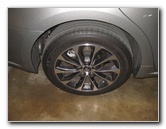 2016 Avalon Rear Wheel |
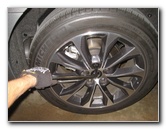 Slightly Loosen Lug Nuts |
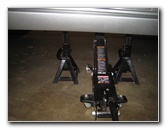 Raise Rear of Vehicle |
|
This automotive maintenance tutorial was specifically written to assist owners of the fourth generation (2013, 2014, 2015, 2016, 2017 and the revised 2018 model year) Toyota Avalon sedan in changing the rear disc brake pads and lubricating the caliper slider pins. Owners of other Toyota, Lexus and Scion vehicles such as the Yaris, Corolla, Matrix, Prius, Camry, RAV4, Sienna, Tacoma, Tundra, FJ Cruiser, Venza, Highlander, 4Runner, Sequoia, Land Cruiser, IS 250, IS 200t, IS 300, NX 200t, NX 300h, RX 350, RX 450h, LS 460, LS 600h, ES 350, ES 300h Hybrid, RC F, GS 350, CT 200h, LX 570, GX 460, tC, iA, iM, xB, xD, iQ and FR-S may also find these DIY instructions to be helpful. A few compatible replacement rear brake pads with their part numbers are as follows: Wagner ZD1212, Wagner QC1212, Bosch BP1212, Power Stop Z23-1212, KFE KFE1212-104, ACDelco 14D1212CH, Dura International BP1212 Ceramic and genuine OEM Toyota 04466-06200. The tools required to complete this procedure include a lug nut wrench, a floor jack, two jack stands, a 14mm socket with a 3/8" drive ratchet, a "C" or "F" clamp and brake caliper grease. |
||
|
|
||
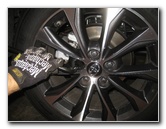 Spin Off Lug Nuts |
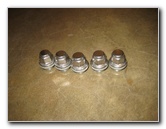 5 Lug Nuts Removed |
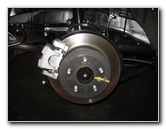 Rear Caliper & Rotor |
| The first two steps
are to park the car on a level surface and turn off the ignition. Make sure that the emergency / parking brake is not engaged. Place wheel chocks on both sides of the front tires to prevent the car from moving. Slightly loosen the five lug nuts by turning them counterclockwise a half turn with the tire iron. Raise the rear of the car with the floor jack and securely support it with at least two jack stands. I prefer to work on one side of the car at a time to keep three tires on the ground for extra safety. Spin off the five lug nuts and set them aside in a safe place. Remove the rear wheel to reveal the caliper, bracket, rotor and suspension. |
||
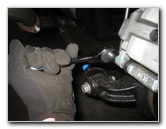 Loosen Lower Caliper Bolt |
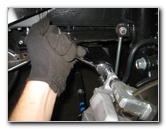 Loosen Upper Caliper Bolt |
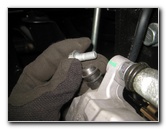 Spin Out Top Bolt |
| The rear brake
caliper is held in to place to the bracket by two bolts located on the back
side of the caliper. The bolt heads face in towards the trunk of the car. Loosen the lower caliper bolt by turning it clockwise (as seen from the outside of the car) with the 14mm socket and a 3/8" drive ratchet. Then loosen the upper 14mm caliper bolt by turning it clockwise (as seen from the outside of the vehicle). |
||
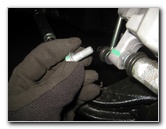 Remove Bottom 14mm Bolt |
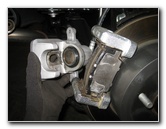 Pull Off Brake Caliper |
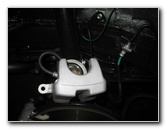 Rest Caliper On Suspension |
| Spin out the two
caliper bolts and set them aside in a safe place. Lift the caliper off the old pads and out of the bracket. Rest the caliper on the suspension or suspend it from the spring with a bungee cord. |
||
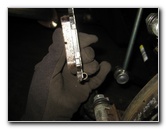 Wear Bar - Bottom Pads |
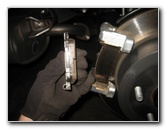 Remove Old Brake Pads |
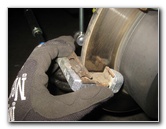 Replace Pad Abutment Clips |
| Pull the old inner
and outer brake pads out of the bracket. Make a mental note of where the wear indicator or "squeal" bars are situated on the old pads. On this 2016 Avalon XLE, the wear bars were located at the bottom of both pads. If your new set of rear pads includes replacement brake hardware, pull the old metal pad abutment or "anti-rattle" clips out of the top and bottom of the bracket. Apply a thin layer of brake caliper grease to the new pad abutment clips where they will come in contact with the caliper bracket or the new pads. Push the new pad abutment clips in to the top and bottom of the bracket. |
||
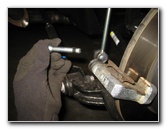 Pull Out Caliper Slider Pins |
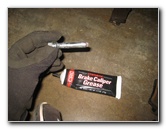 Lubricate Caliper Pins |
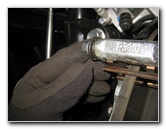 Push Pins Back In Bracket |
| In order for the
caliper to operate smoothly, the two caliper slider pins or "guide bolts"
need to be well lubricated. Pull the upper and lower caliper slider pins out of their rubber dust boots in the bracket. Apply a thin layer of brake parts lubricant grease to the smooth parts of the caliper slider pins. Push the pins back in to their rubber dust boots within the bracket. |
||
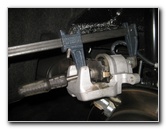 Attach Clamp To Caliper |
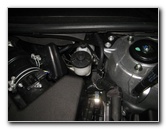 Brake Fluid Reservoir |
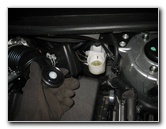 Pull Off Reservoir Cap |
|
In order for the caliper to fit over the thicker new brake pads, you will need to compress back the caliper piston. Attach a "C" or "F" clamp to the rear caliper and use the back of an old brake pad to evenly distribute the pressure across the piston. Move to the right rear area of the engine bay, closest to the driver's seat, and gently pull off the brake fluid reservoir cap. Removing the reservoir cap will allow the brake fluid to more easily travel back through the lines when you compress the piston. |
||
|
|
||
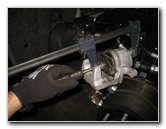 Compress Caliper Piston |
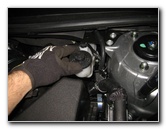 Replace Brake Fluid Cap |
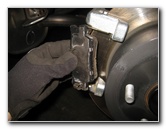 Install New Outer Pad |
| Slowly turn the "F"
clamp handle in the clockwise direction to push the piston back in to the
caliper. Try to avoid pinching or otherwise damaging the rubber dust boot that surrounds the piston. Repeatedly check the level in the reservoir to prevent it from over flowing. Clean up any spilled brake fluid immediately since it can quickly damage painted surfaces. Push the reservoir cap back in to place as soon as possible since brake fluid is hygroscopic (readily absorbs moisture from the air). Thoroughly clean off the brake rotor, caliper bracket, brake caliper assembly and the lug nut studs with brake parts cleaner spray. Do not use compressed air or blow with your mouth to clean off the brake parts since inhaling brake dust can be harmful to your health. Brake dust may be carcinogenic (causes cancer) if inhaled. Apply a thin layer of brake parts lubricant to any area where there is metal to metal contact such as the outer lip of the caliper piston. Do not apply brake caliper grease to the friction surface of the new pads.
To remove the existing rotors and install new ones, remove the two bolts on the rear of the caliper bracket that attach it to the steering knuckle. Then loosen the old rotor with a rubber mallet, pull it off, and slide the new one in its place. If you have trouble removing the rotor, pull out the rubber plug on the face of the rotor and use a flathead screwdriver to turn the emergency parking brake adjuster wheel to back the parking brake away from the drum part of the rotor. |
||
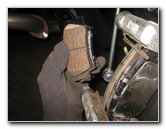 Wear Bars - Bottom Pads |
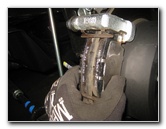 Push Pads Against Rotor |
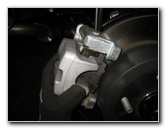 Lower Caliper Over Pads |
| I recommend buying
the Wagner QC1212 "ThermoQuiet"
brake pads since they have excellent reviews on Amazon and include all of
the replacement hardware. Install the new brake pads in to the bracket with the wear bars located at the bottom of both pads. Push the two brake pads together until they are flush against the rotor. Carefully lower the caliper over the new brake pads and in to the bracket. |
||
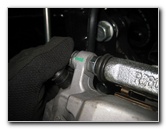 Spin In Top Caliper Bolt |
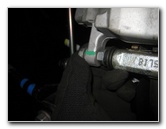 Replace Bottom Bolt |
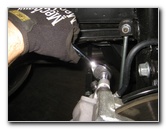 Tighten Upper 14mm Bolt |
| Spin the two caliper bolts a few turns by hand in the counterclockwise direction (as seen from the outside of the car) to prevent them from becoming cross threaded. | ||
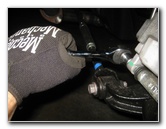 Tighten Lower Bolt |
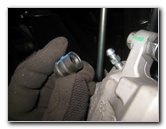 Brake Fluid Bleeder Valve |
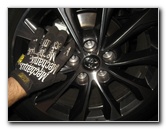 Replace Rear Wheel |
| Tighten the two
caliper bolts with the 14mm socket and a 3/8" drive ratchet to just past
hand tight or about 25 lb-ft of torque. Double check that the caliper bolts are tight before moving on to the next steps. If your brake pedal feels soft or spongy, the brake fluid might be contaminated with water or the brake lines may contain a few air bubbles. It would be best to bleed the brake lines at this time in order to flush out the old fluid and replace it with new DOT 3 or DOT 4 brake fluid. For more on this topic, check out my Brake Line Fluid Bleeding With An Assistant DIY Guide or alternatively the Brake Line Fluid Bleeding With A Power Bleeder Guide. The 8mm brake fluid bleeder valve is located underneath a rubber cap on the back side of the caliper just below the top caliper bolt. Replace the rear wheel and spin on the five lug nuts in the clockwise direction a few turns by hand to prevent them from becoming cross threaded. |
||
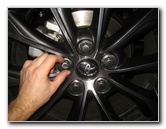 Spin On Five Lug Nuts |
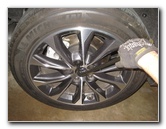 Torque To 76 lb-ft |
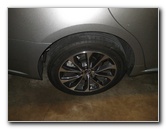 Rear Brake Pads Replaced |
| Slightly tighten
the five lug nuts in the clockwise direction with the tire iron in a "criss
cross" or star pattern. Carefully lower the rear of the car from the jack stands by using the floor jack. Continue tightening the lug nuts in the clockwise direction in a "criss cross" or star pattern to about 1/4 to 1/3 turn past hand tight or 76 lb-ft of torque. It would be best to use a torque wrench or an electric impact wrench with a torque stick to make sure that the lug nuts are properly tightened. Sit in the driver's seat of the car and firmly pump the brake pedal a few times to restore the brake line pressure. Check the brake fluid in the reservoir and verify that it is at the proper level. If it is low, pour in some fresh DOT 3 or DOT 4 fluid. To break in your new rear brake pads, just drive normally for the first several hundred miles while trying to avoid any hard or "panic" stops which may glaze over the new pads and cause them to become noisy and not perform as well. It's also a good idea to regularly check your driveway, garage or parking spot for drops of brake fluid which may indicate a leak, check the brake fluid level in the reservoir and also verify that the lug nuts are still tight. For more,
check out all of my
Toyota Avalon DIY Repair & Maintenance Guides. |
||
| If you found this guide to be helpful,
please consider making a small donation by clicking on the PayPal.com
"Donate" button located to the right of this paragraph. Thank you!
(Note: I am not a registered charity. Donations are not tax deductible.) |

